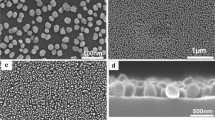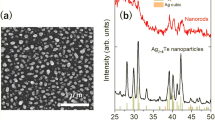Abstract
1D material systems such as Ag–Ni, Ag–Co, Ag–Fe nanowires or nanotubes have tremendous potential for making devices that require the coexistence of electrically conducting and magnetic phases and interfaces. The realization of such microstructures is very challenging essentially due to their high positive mixing enthalpies which makes it difficult to achieve unique non-equilibrium microstructures. In the present exploration, silver–nickel nanotubes were synthesized by adopting the electrodeposition technique. Detailed microstructural characterization of the nanotubes was carried out by using electron microscopy technique. The transmission electron microscopic examinations revealed that the microstructure of the nanotube consisted of nearly spherical, Ag–Ni nanoparticles encapsulated in a Ni-rich amorphous matrix. Ag–Ni nanoparticles exhibited two types of structures. The small-sized particles had single-phase crystal structure, whereas large-sized particles exhibited multiple twinned structure. Mechanism of formation of the nanotube involved the nucleation and subsequent growth of Ag–Ni nanoparticles inside the alumina template. Owing to the twinned structure, few nanoparticles grow larger and decomposed into Ag-rich and Ni-rich clusters that eventually matured to the nanotube.












Similar content being viewed by others
References
K. Ramachandran, K. Justice Babu, K. Ramachandran, K. Justice Babu, Ni-Co bimetal nanowires filled multiwalled carbon nanotubes for the highly sensitive and selective non-enzymatic glucose sensor applications. Sci. Rep. 6, 36583 (2016). https://doi.org/10.1038/srep36583
L. Dimesso, G. Miehe, H. Fuess, H. Hahn, L. Dimesso, G. Miehe, H. Fuess, H. Hahn, Preparation of nanostructured granular Ag–Co and Ag–Fe alloys by gas flow condensation technique. J. Magn. Magn. Mater. 191, 162–168 (1999). https://doi.org/10.1016/S0304-8853(98)00326-6
C.-C. Lee, D.-H. Chen, C.-C. Lee, D.-H. Chen, Large-scale synthesis of Ni–Ag core–shell nanoparticles with magnetic, optical and anti-oxidation properties. Nanotechnology. 17, 3094 (2006). https://doi.org/10.1088/0957-4484/17/13/002
H. Guo, Y. Chen, X. Chen, R. Wen, G.-H. Yue, D.-L. Peng, H. Guo, Y. Chen, X. Chen, R. Wen, G.-H. Yue, D.-L. Peng, Facile synthesis of near-monodisperse Ag@ Ni core–shell nanoparticles and their application for catalytic generation of hydrogen. Nanotechnology. 22, 195604 (2011). https://doi.org/10.1088/0957-4484/22/19/195604
S. Xu, Z.L. Wang, S. Xu, Z.L. Wang, One-dimensional ZnO nanostructures: solution growth and functional properties. Nano Res. 4, 1013–1098 (2011). https://doi.org/10.1007/s12274-011-0160-7
R.K. Rai, C. Srivastava, R.K. Rai, C. Srivastava, Nonequilibrium microstructures for Ag–Ni nanowires. Microsc. Microanal. 21, 491–497 (2015). https://doi.org/10.1017/S1431927615000069
C. Srivastava, R.K. Rai, C. Srivastava, R.K. Rai, Transmission electron microscopy study of Ni-rich, Ag–Ni nanowires. Chem. Phys. Lett. 575, 91–96 (2013). https://doi.org/10.1016/j.cplett.2013.05.011
M. Singleton, P. Nash, M. Singleton, P. Nash, The Ag–Ni (Silver–Nickel) system. J. Phase Equilibria. 8, 119–121 (1987). https://doi.org/10.1007/BF02873194
S.V. Aert, K.J. Batenburg, M.D. Rossell, R. Erni, G.V. Tendeloo, S.V. Aert, K.J. Batenburg, M.D. Rossell, R. Erni, G.V. Tendeloo, Three-dimensional atomic imaging of crystalline nanoparticles. Nature. 470, 374–377 (2011). https://doi.org/10.1038/nature09741
G. Radnóczi, E. Bokanyi, Z. Erdélyi, F. Misják, G. Radnóczi, E. Bokanyi, Z. Erdélyi, F. Misják, Size dependent spinodal decomposition in Cu-Ag nanoparticles. J. Actamat. 123, 82–89 (2017). https://doi.org/10.1016/j.actamat.2016.10.036
C. Srivastava, S. Chithra, K.D. Malviya, S.K. Sinha, K. Chattopadhyay, C. Srivastava, S. Chithra, K.D. Malviya, S.K. Sinha, K. Chattopadhyay, Size dependent microstructure for Ag–Ni nanoparticles. Acta Mater. 59, 6501–6509 (2011). https://doi.org/10.1016/j.actamat.2011.07.022
C. Srivastava, C. Srivastava, Phase separation by nanoparticle splitting. Mater. Lett. 70, 122–124 (2012). https://doi.org/10.1016/j.matlet.2011.11.079
H. Hofmeister, H. Hofmeister, Forty years study of fivefold twinned structures in small particles and thin films. Cryst. Res. Technol. 33, 3–25 (1998). https://doi.org/10.1002/(SICI)1521-4079(1998)33:1%3c3::AID-CRAT3%3e3.0.CO;2-3
V.V. Volkov, G. Van Tendeloo, G.A. Tsirkov, N.V. Cherkashina, M.N. Vargaftik, I.I. Moiseev, V.M. Novotortsev, A.V. Kvit, A.L. Chuvilin, V.V. Volkov, G. Van Tendeloo, G.A. Tsirkov, N.V. Cherkashina, M.N. Vargaftik, I.I. Moiseev, V.M. Novotortsev, A.V. Kvit, A.L. Chuvilin, Long-and short-distance ordering of the metal cores of giant Pd clusters. J. Cryst. Growth. 163, 377–387 (1996). https://doi.org/10.1016/0022-0248(95)01008-4
G. Radnóczi, E. Bokanyi, Z. Erdélyi, F. Misják, G. Radnóczi, E. Bokanyi, Z. Erdélyi, F. Misják, Size dependent spinodal decomposition in Cu-Ag nanoparticles. Acta Mater. 123, 82–89 (2017). https://doi.org/10.1016/j.actamat.2016.10.036
T.P. Martin, T. Bergmann, H. Göhlich, T. Lange, T.P. Martin, T. Bergmann, H. Göhlich, T. Lange, Evidence for icosahedral shell structure in large magnesium clusters. Chem. Phys. Lett. 176, 343–347 (1991)
Acknowledgements
The authors acknowledge the funding received from the SERB Govt. of India.
Author information
Authors and Affiliations
Corresponding author
Ethics declarations
Conflict of interest
The authors declare that there is no conflict of interest.
Additional information
Publisher's Note
Springer Nature remains neutral with regard to jurisdictional claims in published maps and institutional affiliations.
Rights and permissions
About this article
Cite this article
Rai, R.K., Srivastava, C. Synthesis and Mechanism of Formation of Non-equilibrium Ag–Ni Nanotubes. Metallogr. Microstruct. Anal. 10, 86–95 (2021). https://doi.org/10.1007/s13632-021-00713-1
Received:
Revised:
Accepted:
Published:
Issue Date:
DOI: https://doi.org/10.1007/s13632-021-00713-1




